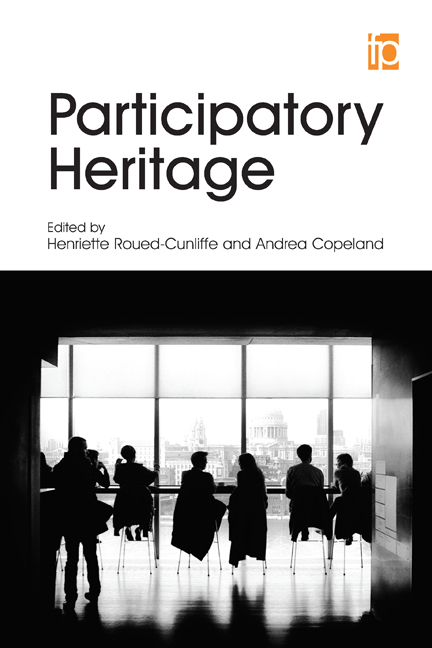Book contents
- Frontmatter
- Contents
- List of figures and tables
- Contributors
- Introduction: what is participatory heritage?
- Part 1 Participants
- 1 A communal rock: sustaining a community archives in Flat Rock, Georgia
- 2 The Bethel AME Church Archive: partners and participants
- 3 Creating an authentic learning environment for school children: a case study of digital storytelling programmes at the Mudgeeraba Light Horse Museum
- 4 Viking re-enactment
- 5 Learning, loving and living at the Australian Country Music Hall of Fame
- 6 The contributions of family and local historians to British history online
- 7 Forgotten history on Wikipedia
- Part 2 Challenges
- Part 3 Solutions
- Further reading
- Index
3 - Creating an authentic learning environment for school children: a case study of digital storytelling programmes at the Mudgeeraba Light Horse Museum
from Part 1 - Participants
Published online by Cambridge University Press: 08 June 2018
- Frontmatter
- Contents
- List of figures and tables
- Contributors
- Introduction: what is participatory heritage?
- Part 1 Participants
- 1 A communal rock: sustaining a community archives in Flat Rock, Georgia
- 2 The Bethel AME Church Archive: partners and participants
- 3 Creating an authentic learning environment for school children: a case study of digital storytelling programmes at the Mudgeeraba Light Horse Museum
- 4 Viking re-enactment
- 5 Learning, loving and living at the Australian Country Music Hall of Fame
- 6 The contributions of family and local historians to British history online
- 7 Forgotten history on Wikipedia
- Part 2 Challenges
- Part 3 Solutions
- Further reading
- Index
Summary
Sunday morning, 21 February, 2016: Ten students and their parents gathered at the Mudgeeraba Light Horse museum for the ‘Long Tan Filming Day’. Long Tan was an ‘against all odds’ win for Australian troops early in Australia's involvement in the Vietnam War. Students at the museum that day were aiming to submit a work, in a form of their choosing, for a competition honoring 50 years since the Long Tan battle. The filming day started with introductory talks about the battle, Australia's base at Nui Dat, weaponry and context – the social revolution of the sixties. Then the day got interesting. Students set up their video-recording gear in each of three interview rooms, and in turn interviewed each of the three Vietnam veterans (Figure 3.1). They captured first-person accounts, providing new primary source materials, and the students’ creative works emerging from the day were inspired. What emerged is a useful activity that creates archival materials relevant to museums, galleries, libraries and archives, and an outlet for students’ creative expression.
IN 2015, I CONDUCTED research at the Mudgeeraba Light Horse Museum (the museum), situated in South-East Queensland, Australia, exploring the value of the museum's Digital Storytelling (DST) programme as a learning activity for high school students (Hanley, 2015). The museum honours Light Horsemen and all men and women who served during the Boer War, the two World Wars and modern conflicts. Its collection was started in 1998, and it was formally incorporated as a museum in 2012. The museum shares its site with a National Servicemen's branch: the ‘Nashos’ and their partners make up the majority of the museum volunteers, the average age of volunteers being over 75.
This chapter is a case study of the museum focusing on the authentic learning environment that developed as the DST programme evolved. This progress was enabled by the participation of willing teachers and volunteers keen to learn and to respond – ‘communities of practice’ (CoP) (Wenger, 1998; see also Baker, Chapter 5 in this volume). The case study is framed in terms of theories of situated learning, drawing on the framework developed by Herrington and Oliver (2000).
- Type
- Chapter
- Information
- Participatory Heritage , pp. 25 - 36Publisher: FacetPrint publication year: 2017



